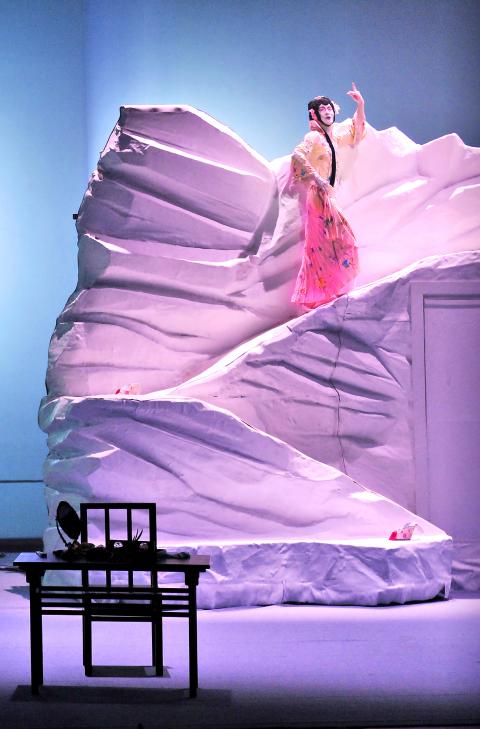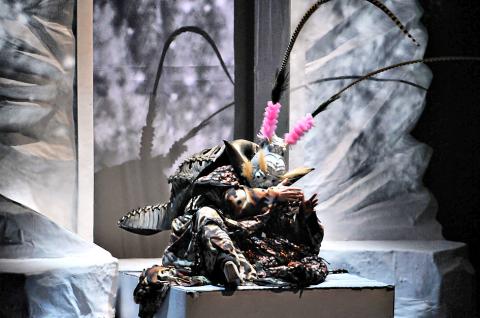Late existentialist writer Franz Kafka turned Gregor Samsa, the main character in his 1915 novella The Metamorphosis into a monstrous insect. Nearly a century later, Taiwanese theater veteran Wu Hsing-kuo (吳興國) becomes the bug, as well as a bird and all the female characters in Kafka’s story.
Metamorphosis (蛻變), a recent production of Wu’s Contemporary Legend Theater (當代傳奇劇場) that premiered earlier this year at UK’s Edinburgh International Festival, sees the actor-dramatist in a solo performance.
Fusing traditions of the East and West has always been Wu’s forte. The troupe’s repertoire comprises adapted European classics such as The Tempest and Macbeth by Shakespeare and a number of Greek tragedies including Medea and The Oresteia, among other works based on modern literature and traditional Beijing opera.

Photo courtesy of Contemporary Legend Theater
In King Lear, Wu carried out a solo tour-de-force, depicting multiple characters simultaneously and wowing sold out theaters worldwide. He will perform the same physically and emotionally-demanding act in Metamorphosis, in which he morphs from a man to a bug, to a woman and a bird. The show returns to Taiwan’s National Theater in December.
KAFKA AND WOMEN
Wu said at a recent press event that he read many of Kafka’s novels — not just The Metamorphosis — to learn more about him. He found the most inspiration in Kafka’s love letters.

Photo courtesy of Contemporary Legend Theater
“I saw who Kafka really was from the love letters he wrote to his girlfriends, where he revealed a more sensitive personality,” Wu said.
Wu examines this other face of Kafka in Love, one of the six scenes that make up Metamorphosis, where he changes into a woman.
“In the novels, Kafka gives us a strong character. In his love letters, however, we see how he perceives women, the tone he uses to speak with women … It shows another side of him. It is a pity if I leave that out of my play,” Wu told the Taipei Times.

Photo courtesy of Contemporary Legend Theater
In Love, Wu wears a rosy two-piece traditional Chinese dress with floral print and full make-up, fitting his feet into a pair of 3-inch stilts to achieve a feminine look.
Wu said that imitating a woman and a bug are equally challenging. “As you know, the bug in Kafka’s book has nothing to do with any natural insect. It is a monster created by a human. After brainstorming with Lai Hsuen-wu (賴宣吾), we remodeled the Kao (靠) — a kind of armor in Beijing opera — to build the costume,” he added. Lai, as the show’s costume designer, planned several striking looks for Wu, including one that requires Wu to sing in a white and tight-fitting bodysuit with a face inked on his forehead.
Although it is an adaptation, Metamorphosis follows no linear storyline or plot. Wu called the scenes his “six dreams,” in which he delivers Kafka’s thinking in Eastern-style theatrical language and sings the lyrics written by author Chang Da-chun (張大春), adding a surreal dimension to the original narration.
Wu believes that reinventing tradition and innovating are the responsibility of today’s artists.
“[You] cross disciplines and mix match different genres until the boundaries blur, until you can’t really tell what’s Eastern and Western anymore,” he said.

In the March 9 edition of the Taipei Times a piece by Ninon Godefroy ran with the headine “The quiet, gentle rhythm of Taiwan.” It started with the line “Taiwan is a small, humble place. There is no Eiffel Tower, no pyramids — no singular attraction that draws the world’s attention.” I laughed out loud at that. This was out of no disrespect for the author or the piece, which made some interesting analogies and good points about how both Din Tai Fung’s and Taiwan Semiconductor Manufacturing Co’s (TSMC, 台積電) meticulous attention to detail and quality are not quite up to

April 21 to April 27 Hsieh Er’s (謝娥) political fortunes were rising fast after she got out of jail and joined the Chinese Nationalist Party (KMT) in December 1945. Not only did she hold key positions in various committees, she was elected the only woman on the Taipei City Council and headed to Nanjing in 1946 as the sole Taiwanese female representative to the National Constituent Assembly. With the support of first lady Soong May-ling (宋美齡), she started the Taipei Women’s Association and Taiwan Provincial Women’s Association, where she

Chinese Nationalist Party (KMT) Chairman Eric Chu (朱立倫) hatched a bold plan to charge forward and seize the initiative when he held a protest in front of the Taipei City Prosecutors’ Office. Though risky, because illegal, its success would help tackle at least six problems facing both himself and the KMT. What he did not see coming was Taipei Mayor Chiang Wan-an (將萬安) tripping him up out of the gate. In spite of Chu being the most consequential and successful KMT chairman since the early 2010s — arguably saving the party from financial ruin and restoring its electoral viability —

It is one of the more remarkable facts of Taiwan history that it was never occupied or claimed by any of the numerous kingdoms of southern China — Han or otherwise — that lay just across the water from it. None of their brilliant ministers ever discovered that Taiwan was a “core interest” of the state whose annexation was “inevitable.” As Paul Kua notes in an excellent monograph laying out how the Portuguese gave Taiwan the name “Formosa,” the first Europeans to express an interest in occupying Taiwan were the Spanish. Tonio Andrade in his seminal work, How Taiwan Became Chinese,